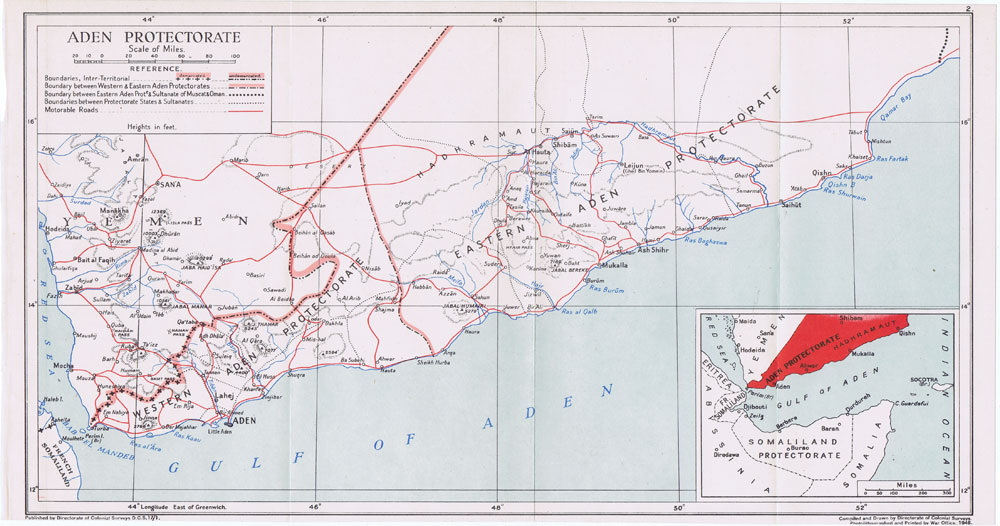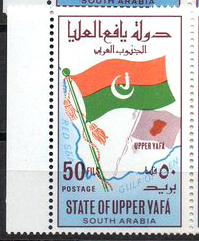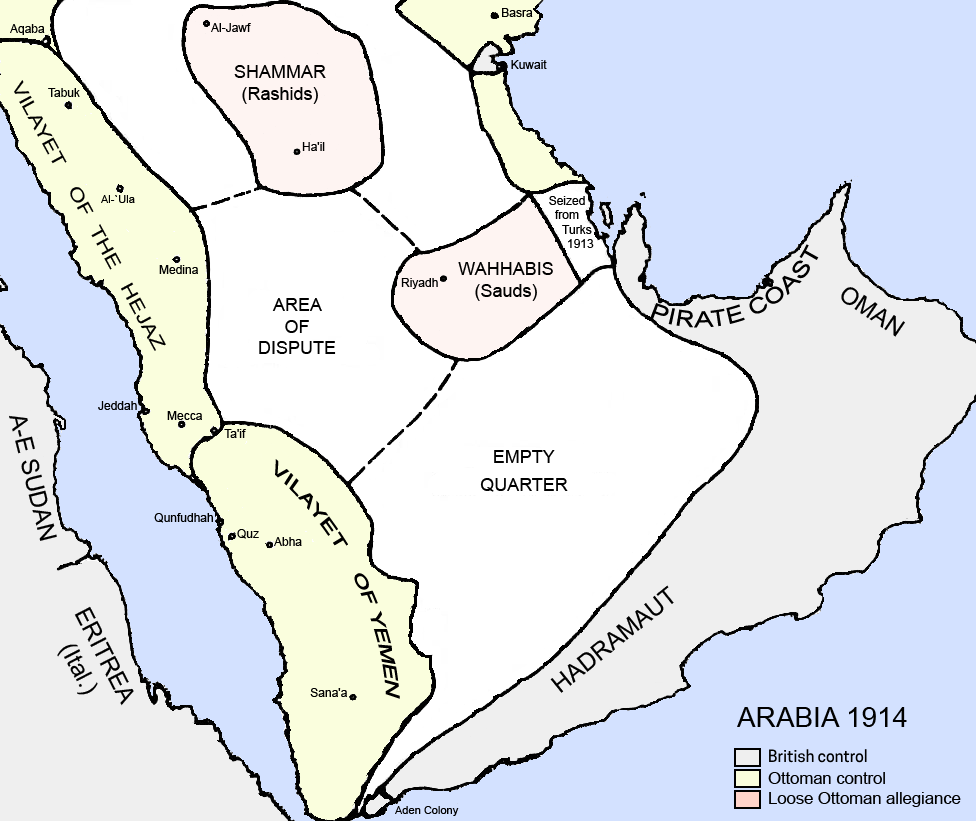|
Al-Busi
Al-Bu`si, Busi, Bo'sī, ( ''Bu`sī''), or the Bu`si Sheikhdom ( ''Mashyakhat al-Bu`sī''), was a small state in the British Aden Protectorate. It was one of the states of Upper Yafa. History Busi was established around the 18th century. Protectorate treaties were signed with the other states of Upper Yafa in 1903, but Busi was excluded and remained independent. Between 1903 and 1954, two different sheikhs of Busi, father and son, attempted to obtain a protectorate treaties, but Britain denied their applications on the ground that it was undesirable to multiply the number of treaty chiefs, among other reasons. Although Busi was not allowed to enter into the British protectorate, the Sheikhs were still entitled to an annual visit to Aden. The Sheikh of Busi was one of the rulers of South Arabian states attending the second Lahej conference in 1930. In August 1954, a request for a protectorate treaty by the Sheikh of Busi was forwarded by Tom Hickinbotham, the Governor of Aden, to A ... [...More Info...] [...Related Items...] OR: [Wikipedia] [Google] [Baidu] |
Aden Protectorate
The Aden Protectorate ( ar, محمية عدن ') was a British protectorate in South Arabia which evolved in the hinterland of the port of Aden and in the Hadhramaut following the conquest of Aden by the Bombay Presidency of British India in 1839, and it continued until the 1960s. In 1940 it was divided for administrative purposes into the Western Protectorate and the Eastern Protectorate. Today the territory forms part of the Republic of Yemen. The rulers of the Aden Protectorate, as generally with the other British protectorates and protected states, remained sovereign: their flags still flew over their government buildings, government was still carried out by them or in their names, and their states maintained a distinct 'international personality' in the eyes of international law, in contrast to states forming part of the British Empire, such as Aden Colony, where the British monarch was the head of every state. History Informal beginnings What became known as the ... [...More Info...] [...Related Items...] OR: [Wikipedia] [Google] [Baidu] |
Upper Yafa
Upper Yafa or Upper Yafa'i ( ar, يافع العليا ''),'' officially State of Upper Yafa ( ar, دولة يافع العليا '')'', was a military alliance in the British Aden Protectorate and the Protectorate of South Arabia. It was ruled by the Harharah dynasty and its capital was Mahjaba, a small town on a hill located by road 621, about 50 km northeast of Habilayn. The sultan of Upper Yafa had very little control over Upper Yafa's constituent sheikdoms, which had separate protectorate treaties with the British, and were free to disassociate from the policies of the Upper Yafa sheikh. The only time that the Upper Yafa sheikh held influence was during a crisis that threatened the independence of Upper Yafa's states, during which they would unite under the sultan. This meant that Upper Yafa was more akin to a military alliance than a genuine state. History The Yafa'i tribe has traditionally inhabited the mountainous hinterland of the Aden area. Upper Yafa was fo ... [...More Info...] [...Related Items...] OR: [Wikipedia] [Google] [Baidu] |
Protectorate Of South Arabia
The Protectorate of South Arabia consisted of various states located at the southern end of the Arabian Peninsula under treaties of protection with Britain. The area of the former protectorate became part of South Yemen after the Radfan uprising and is now part of the Republic of Yemen. History Background The background of the Protectorate of South Arabia is part of an effort of the British Empire to protect the East India Route, the sea route between the Mediterranean Sea and India, in and through the southern coasts of Arabia. Already before the opening of the Suez Canal, industrial Britain with its rapidly expanding economy, needed improved communication with British India. The coastal plains of the peninsula had been devastated earlier in the 19th century by Wahhabi puritan Muslims from Central Arabia followed by an Egyptian invasion. From the first commercial treaty with the Sultanate of Lahej in 1802, various efforts were made to avoid looting of East India ships, ... [...More Info...] [...Related Items...] OR: [Wikipedia] [Google] [Baidu] |
Sin Escudo
In a religious context, sin is a transgression against divine law. Each culture has its own interpretation of what it means to commit a sin. While sins are generally considered actions, any thought, word, or act considered immoral, selfish, shameful, harmful, or alienating might be termed "sinful". Etymology From Middle English sinne, synne, sunne, zen, from Old English synn (“sin”), from Proto-West Germanic *sunnju, from Proto-Germanic *sunjō (“truth, excuse”) and *sundī, *sundijō (“sin”), from Proto-Indo-European *h₁s-ónt-ih₂, from *h₁sónts ("being, true", implying a verdict of "truly guilty" against an accusation or charge), from *h₁es- (“to be”); compare Old English sōþ ("true"; see sooth). Doublet of suttee. Bahá'í Baháʼís consider humans to be naturally good, fundamentally spiritual beings. Human beings were created because of God's immeasurable love for us. However, the Baháʼí teachings compare the human heart to a mirror, wh ... [...More Info...] [...Related Items...] OR: [Wikipedia] [Google] [Baidu] |
Federation Of South Arabia
The Federation of South Arabia ( ar, اتحاد الجنوب العربي ') was a federal state under British protection in what would become South Yemen. Its capital was Aden. It was formed on 4 April 1962 from the 15 protected states of the Federation of Arab Emirates of the South. The State of Aden, formerly Aden Colony, joined the Federation on 18 January 1963. In June 1964, the Upper Aulaqi Sultanate was added for a total of 17 states. A team was sent to the 1966 Commonwealth Games in Kingston, Jamaica. The Federation was abolished on 30 November 1967, when its status as a British protectorate came to an end, along with that of the Protectorate of South Arabia, and they became the People's Democratic Republic of Yemen. States * Aden * Alawi * Aqrabi * Audhali * Beihan * Dathina * Dhala * Fadhli * Haushabi * Lahej * Lower Aulaqi * Lower Yafa * Maflahi * Shaib * Upper Aulaqi Sheikhdom * Upper Aulaqi Sultanate * Wahidi Balhaf Leaders Chief Ministers * Has ... [...More Info...] [...Related Items...] OR: [Wikipedia] [Google] [Baidu] |
Mutawakkilite Kingdom Of Yemen
The Mutawakkilite Kingdom of Yemen ( ar, المملكة المتوكلية اليمنية '), also known as the Kingdom of Yemen or simply as Yemen, or, retrospectively, as North Yemen, was a state that existed between 1918 and 1962 in the northwestern part of what is now Yemen. Its capital was Sana'a until 1948, then Taiz. From 1962 to 1970, it maintained control over portions of Yemen (frequently most) until its final defeat in the North Yemen Civil War. Yemen was admitted to the United Nations on 30 September 1947. History Background Zaidi religious leaders expelled forces of the Ottoman Empire from what is now northern Yemen by the middle of the 17th century but, within a century, the unity of Yemen was fractured due to the difficulty of governing Yemen's mountainous terrain. In 1849, the Ottoman Empire occupied the coastal Tihamah region to put pressure on the Zaiddiyah imam to sign a treaty recognizing Ottoman suzerainty and allowing for a small Ottoman force to b ... [...More Info...] [...Related Items...] OR: [Wikipedia] [Google] [Baidu] |
Al-Dhubi
Al-Dhubi, Al-Dubi ( ''Dhubī''), or the Dhubi Sheikhdom ( ''Mashyakhat ad-Dhubī''), was a small state in the British Aden Protectorate. Dhubi was located between Mawsata in the southwest, Hadrami in the northeast, Lower Yafa in the south and Upper Yafa in the north. Its last sheikh was deposed in 1967 upon the founding of the People's Republic of South Yemen and the area is now part of the Republic of Yemen. History Al-Dhubi was one of the five sheikhdoms of Upper Yafa. It entered into a protectorate treaty with Britain on 11 May 1903. It was part nominally of the Western Aden Protectorate. Al-Dhubi never joined the Federation of South Arabia, but became part of the Protectorate of South Arabia between 1963 and 1967. Rulers Al-Dhubi was ruled by sheikhs who bore the title ''Shaykh al-Mashyakha ad-Dhubiyya''. Sheikhs *c.1750 - 1780 Muhammad *c.1780 - 1810 Jabir ibn Muhammad *c.1810 - 1840 `Atif ibn Jabir *c.1840 - 1870 ... [...More Info...] [...Related Items...] OR: [Wikipedia] [Google] [Baidu] |
People's Republic Of South Yemen
South Yemen ( ar, اليمن الجنوبي, al-Yaman al-Janubiyy), officially the People's Democratic Republic of Yemen (, ), also referred to as Democratic Yemen (, ) or Yemen (Aden) (, ), was a communist state that existed from 1967 to 1990 as a state in the Middle East in the southern and eastern provinces of the present-day Republic of Yemen, including the island of Socotra. South Yemen's origins can be traced to 1874 with the creation of the British Colony of Aden and the Aden Protectorate, which consisted of two-thirds of the present-day Yemen. Prior to 1937 what was to become the Colony of Aden had been governed as a part of British India, originally as the Aden Settlement subordinate to the Bombay Presidency and then as a Chief Commissioner's province. After the collapse of Aden Protectorate, a state of emergency was declared in 1963, when the National Liberation Front (NLF) and the Front for the Liberation of Occupied South Yemen (FLOSY) rebelled against the B ... [...More Info...] [...Related Items...] OR: [Wikipedia] [Google] [Baidu] |
Lahej
Lahij or Lahej ( ar, لحج, Laḥj, links=no), also called al-Hawtah, is a city and an area located between Ta'izz and Aden in Yemen. From the 18th to the 20th century, its rulers were of the Abdali branch of the Al-Sallami tribe who trace their lineage to one of the 10 tribes of Yaffa called Kalad. Lahij was the capital city of Sultanate of Lahej, a protectorate of the British Empire until 1967, when the sultan was expelled and the city became a part of People's Republic of South Yemen. It is located in the delta of the Wadi Tuban on the main trade route connecting Aden with Ta'izz, Ibb, and Sanaa. Al-Hawtah is known for the shrine of al-Salih Muzahim Ja'far, which attracts pilgrims from throughout Yemen during the month of Rajab. It is known as "al-Hawtah al-Ja'fariyyah" in his honor. History The capital of Lahj used to be at al-Ra'ra', which was destroyed when the Ottomans conquered the Tahirids in the early 1500s and then all but disappears from historical records. Al ... [...More Info...] [...Related Items...] OR: [Wikipedia] [Google] [Baidu] |
Alan Lennox-Boyd, 1st Viscount Boyd Of Merton
Alan Tindal Lennox-Boyd, 1st Viscount Boyd of Merton, CH, PC, DL (18 November 1904 – 8 March 1983), was a British Conservative politician. Background, education and military service Lennox-Boyd was the son of Alan Walter Lennox-Boyd by his second wife Florence Annie, daughter of James Warburton Begbie and Anna Maria née Reid. He had an elder half-sister and three full brothers, two of whom were killed in the Second World War and one who died in Germany in April 1939. He was educated at Sherborne School, Dorset, and graduated from Christ Church, Oxford, with a BA later promoted to MA. In the Second World War he saw active service as a lieutenant in the Royal Naval Volunteer Reserve with Coastal Forces. Political career Lennox-Boyd was elected as Member of Parliament (MP) for Mid Bedfordshire in 1931 (at the age of 26), and was admitted to Inner Temple, as a barrister in 1941. He was a member of Winston Churchill's peacetime government as Minister for Transport and C ... [...More Info...] [...Related Items...] OR: [Wikipedia] [Google] [Baidu] |



